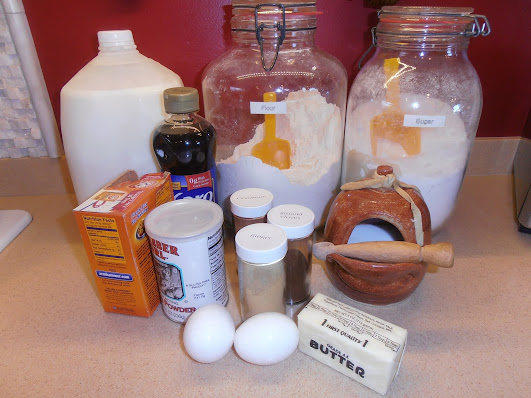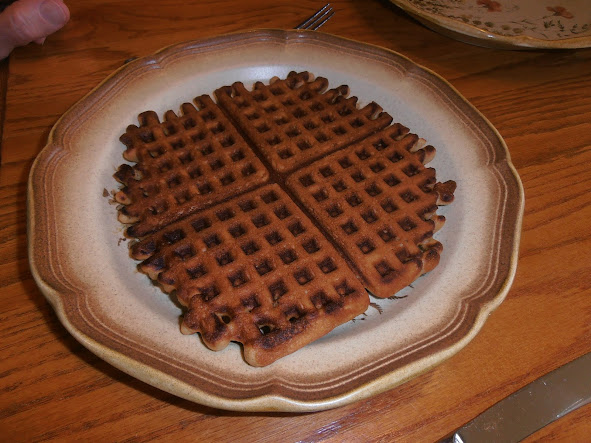This is one of my favorite cookbooks and I was astonished when I realized that I had not put any of its recipes into my blog: Spoonbread and Strawberry Wine, by Norma Jean and Carole Darden, published in 1978 and then 1994.
 |
| ISBN 0-385-47270-6 |
Why is this my favorite? Because of the family stories that are connected to the recipes, because the family itself is inspiring and accomplished, and because of the obvious love the authors have for their family.
For example, when describing their grandfather, they wrote (pages 4 - 6):
Family legend has it that in 1868, at the age of fourteen, Charles Henry Darden walked into Wilson, North Carolina. He had no money, no relatives, no friends there, and no one knew where he had come from -- he wouldn't say. Somehow, somewhere in his mysterious fourteen years, he had gained considerable skill as a blacksmith and could make and repair wheels. These abilities allowed him to eke out a small living and to put together the long wooden toolbox that was to become his trademark as he traveled door to door repairing broken locks and sharpening knives. In a short time he established a good reputation and at seventeen was able to open a small repair shop at the end of the main street in Wilson.
Charles Darden went on to building his business -- in part to prove to the family of the woman he fell in love with that he was worthy -- and then expanded into other businesses, including a store where he also sold produce he grew, and a funeral parlor. He set an example for his community, taught his ten children the value of hard work, and encouraged them to get a good education. In fact, when his adopted town of Wilson built a high school for black students, they named it after him.
Papa Darden was seldom known to travel, yet he attended the graduations, from elementary to graduate school, of every one of his children. Without a doubt, he must have been the proudest "papa" in the group, for in his lifetime, against many odds, he saw three sons become physicians, two become lawyers, and two become morticians, while two of his daughters became teachers and one a nurse.
Norma Jean and Carole Darden are the daughters of Charles Darden's youngest son, "Bud." They spent time gathering stories and recipes from both sides of their family, and present them in a way that shows the reader what sort of people these family members are or were. They have a lot to be proud of.
There are a variety of recipes that I want to try. I love collard greens in a savory, flavorful broth; I want to try Papa Darden's wines and Aunt Artelia's hush puppies; the hot crab-meat salad looks scrumptious; and the candy recipes are inviting. What I chose was the Gingerbread Waffles, not only because they look good (I love gingerbread and the spice mixture that is in it) but I was in a Sunday-morning brunch kind of mood.
Gingerbread Waffles (page 301)
2 eggs
1/4 cup sugar
1/2 cup molasses
1 cup sour milk (see note)
1 1/2 cups all-purpose flour
1 teaspoon ground ginger
1/4 teaspoon ground cloves
1/4 teaspoon ground cinnamon
1/4 teaspoon salt
1 teaspoon baking soda
1 teaspoon baking powder
1/3 cup melted butter
Beat eggs until light. Add sugar, molasses, and sour milk. Sift dry ingredients together. Add to egg mixture and beat together until smooth. Add butter. Cook as you would regular waffles.
Yield: 6 to 8 servings
Note: To make sour milk, add 1 tablespoon distilled white vinegar to 1 cup milk
My Notes
I didn't have molasses so I substituted dark Karo syrup. I think the molasses would make the flavor richer and bolder.
I made the sour milk first as I know it needs to sit a little while after it is mixed.
The waffle iron started heating as soon as I got out all the ingredients. It always works best when it has had a chance to heat up well before I ever try baking the first waffle.
The eggs were whisked until they were foamy.
Instead of sifting the dry ingredients, I measured them into a bowl and whisked them until they were well-blended.
It didn't take long to beat the batter until it was smooth. This picture was taken after the melted butter was added in:
 |
| It smelled so good with all the spices! |
I brushed a little butter over both sides of the hot waffle iron, then poured the batter onto the center. Every waffle came out beautifully!
The Verdict
My guest taster and I tried them without any spreads or toppings. The spice mixture came through, which is what sells it to me. We also tried them with a little butter and also with some Lemon Goop, which complimented the ginger flavor well. All three ways are recommended!
Lemon Goop is a recipe I have tried several times, as given by Dorie Greenspan. Click here for her recipe. It is easy to make and you also get a great syrup out of it. We have used the goop as a spread on breads, and the syrup in a variety of ways, like mixing it with soy sauce and black pepper to make a tasty marinade for salmon. She also recommends making it into a salad dressing. The goop is lemony and tart, barely sweet, a little salty. You might think it is like lemon curd, but it is mostly concentrated lemon and not at all like the curd.
Success! This recipe made five full waffles, each of which breaks into four small pieces. What we didn't eat was frozen, and I look forward to another Sunday brunch with it.
You just can't go wrong with fixing waffles, and to add the lovely gingerbread spice mix just makes it even better.













